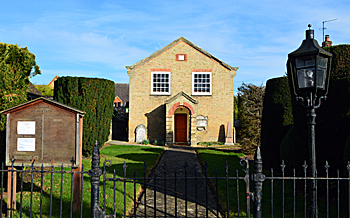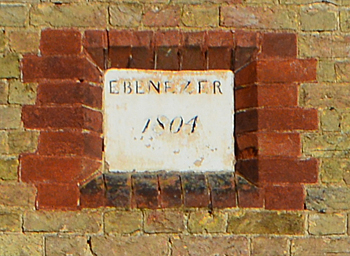Methodism in Tempsford

The Methodist chapel February 2016
Samuel Bennett registered one of the first Wesleyan Methodist chapels in the county in Tempsford in 1794 [ABN1/1, ABN2/71]. It was a converted brewhouse. David Bushby wrote an article on Bennett in a volume of Bedfordshire miscellany published by Bedfordshire Historical Record Society in 1993 - their Volume 72.
Bennett moved to Stonebridge Farm in the 1780s as tenant to Sir Gillies Payne. He had been born in Nottinghamshire 1758. Methodism well established in Saint Neots [Huntingdonshire] already but was slow to take hold in Tempsford. Bennett attended the Baptist chapel in Saint Ives [Huntingdonshire] for a time, then the church at Everton. By chance he met Thomas Linay, a minister in the Saint Ives Circuit (later renamed for Saint Neots); Bennett deplored the state of the village and agreed that Linay would visit Tempsford to preach at the farmhouse. This was successful enough that Tempsford was taken into the circuit.
The new meeting needed more substantial premises if it was to continue and grow its congregation. Accordingly, Bennett approached Sir Gillies Payne for permission to convert an old brewhouse in the Langford End into a chapel. Gillies was anti-Methodist but agreed - this being the premises registered in 1794. Over time the Tempsford society grew. It remained in the Brewhouse-chapel for ten years and even Sir Gillies’ Payne’s own daughters eventually joined.
Sir Gillies died in 1800 and his son John was more hostile towards Methodism. He put pressure on the Meeting and continued use of brewhouse-chapel made Bennett’s tenancy of his house vulnerable. Eventually land was purchased land belonging to Daniel Key at Lambcoat End and chapel was built in 1804 and named Ebenezer. On 16 January 1805 the new Methodist Chapel in Tempsford was registered.

Plaque on the Methodist chapel February 2016
By 1813 the Saint Neots circuit consisted of nine village societies, Tempsford had 45 members and was by far the largest. In the 1820s general membership reached over 90 people. Eventually it steadied at around 55 by the time of Samuel Bennett’s death in 1837. He was succeeded as minister by John Browning senior and junior among others.
The chapel was registered to perform marriages on the 3 April 1838. In the same year the Methodist trustees purchased a cottage in Lamb Coat [Langford] End (erected by William George and formerly in the occupation of Richard Hall and John Gilbert, then converted into three tenements occupied by James Stoney, William Baldock and John Gilbert) from John Lovell, carpenter, for use as a manse [WG2937]. The trustees were: Thomas Tanner of Saint Ives [Huntingdonshire], Charles Armstrong of Wootton, farmer; William Bennett of Leagrave, farmer; John Ekins of Saint Neots [Huntingdonshire], tailor; William Hall of Eaton Socon, butcher and William Cook of Saint Neots, tailor.
In 1842 Joseph Bennett of Tempsford, farmer, conveyed another cottage to the trustees, for £20 [WG2938]. This one was also in Langford End and had lately been occupied by Mary Key, and had since been partly burned down.
On Sunday 30th March 1851 a census of all churches, chapels and preaching houses of every denomination was undertaken in England and Wales. The local results were published by Bedfordshire Historical Records Society in 1975 as Volume 54, edited by D. W. Bushby. The return for Tempsford Wesleyan Methodist Chapel was compiled by John Browning junior, Steward, and reads as follows:
- The chapel was built in 1804
- There were 134 free seats and 116 other seats
- The attendance that morning had been 80 people in the general congregation and 68 in the Sunday School
- The afternoon service had been attended by 130 in the general congregation and 72 in the Sunday School
- The evening service had been attended by 140 people
In 1872 the chapel was renovated at a cost of £114/13/7 [CRT170/6/5] and two new windows probably added. In 1878 John Browning gave land for a Sunday school, which was built at a cost of £156. In 1900 Browning gave more land and a kitchen was built, largely by volunteer labour [CRT170/6/5].
Centenary celebrations in 1904 saw renovation of the chapel. Four years later the last burial took place in the graveyard - the wife of John Browning [CRT170/6/5]. In 1932 the Wesleyan Methodists came together with the Primitive and United Methodists to form the Methodist Church of Great Britain. At the time of writing [2017] the chapel remains open as a place of worship.